What is a Catheter?
A catheter is a hollow, flexible tube which drains urine from your bladder. To prevent the catheter falling out, a small balloon at the catheter tip is inflated inside the bladder. As urine fills your bladder, it drains down the catheter and is collected in a urine bag. You will not need to pass urine yourself while you have a catheter in place.
The catheter will be changed or removed by the district nurse.
The Reasons Why a Catheter is Used
Your doctor will have explained to you why you should have a catheter inserted (it may be due to one of the following):
- Retention of urine.
- Management of urinary incontinence.
- To allow healing after surgery.
- To prevent kidney problems.
You may need to have the catheter in place for a week or more until the area is healed.
Insertion Sites
There are Two Insertion Sites for Catheters
- Urethral
The catheter is inserted via the urethra into the bladder.
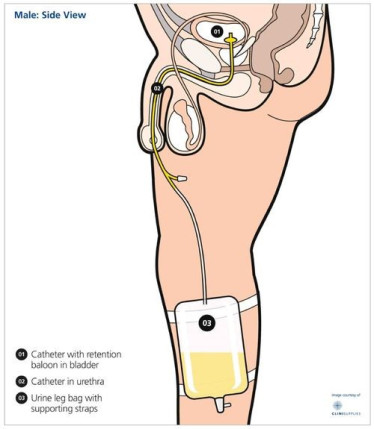
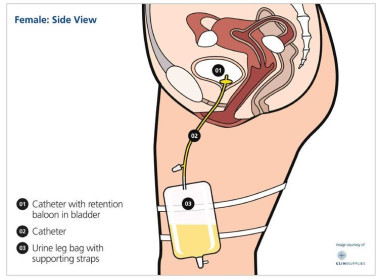
- Suprapubic
A small incision (cut) is made in the abdominal wall just above the pubic bone and the catheter is inserted directly into the bladder.
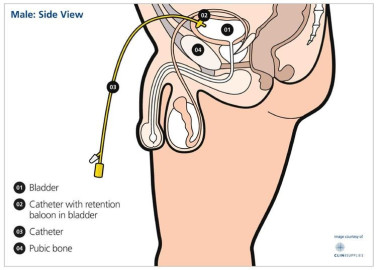
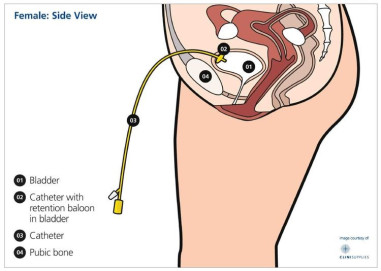
Catheter Cares
Urethral Catheter Cares
- Wash the skin around the area that the catheter enters your body with mild soap and warm water twice a day.
- Shower as normal with the catheter.
- Dry the area thoroughly.
- Never use talcum powder or creams.
- Wash your hands before and after connecting or changing the drainage bag and after every bowel movement.
- Men should retract and wash carefully under their foreskin. Remember to put the foreskin back in place after washing.
NEVER TRY TO REMOVE THE CATHETER
Suprapubic Catheter Cares
This catheter is inserted directly into the bladder through the abdominal wall. A doctor, with a local or general anaesthetic does this initially. It may then be changed by the district nurse.
Remember these simple rules:
- Wash the skin at the insertion site twice a day and dry the area thoroughly.
- Wash your hands before and after connecting or changing the drainage bag and after every bowel movement.
- Never use talcum powder or creams.
- Following your shower gently rotate the catheter between your finger and thumb so it gently turns in the opening
- If the area of the catheter entry becomes red and sore, a swab may be taken by the nurse and sent to the laboratory.
- If infected, antibiotics may be prescribed by your GP.
- The insertion site does not need to be covered with a dressing unless there is a discharge. The catheter should be taped to your abdomen at a 45 degree angle or horizontally to prevent pulling. Do not loop the catheter or tubing upwards, keep as straight as possible.
NEVER TRY TO REMOVE THE CATHETER
How to Keep Your Catheter Working Correctly
- Drink at least eight glasses/cups of fluid in a 24-hour period (unless you have a medical condition that your Doctor has instructed you to restrict your fluid intake).
- Where possible, take regular exercise.
- Avoid constipation, this can affect catheter drainage. If constipation is a problem, ask your Doctor for help or advice.
- Avoid bending or kinking the catheter tubing and ALWAYS keep the drainage bag below the level of your bladder.
- When using an electric blanket, place a draw sheet (or plastic mac with fabric backing) between the electric blanket and the sheet as a preventative measure if leaking occurs.
- Ensure the catheter is secured with an anchoring device such as a soft catheter retaining strap.
- A urethral catheter should be secured to the inner thigh.
- A suprapubic catheter should be secured to the abdomen.
- Empty the drainage bag regularly, it will become heavy and start to pull when it is full.
Leg Bags
You will be given two types of drainage bags - a day bag and a night bag.
Day Bag
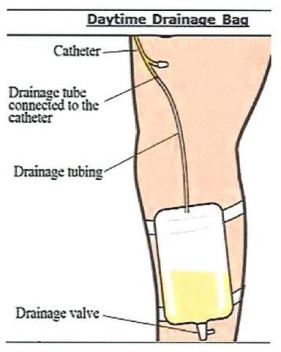
| ➢ A leg bag is worn under your normal clothing during the day.➢ The bag has slits, which allow Velcro straps to pass through so you can secure the bag to your leg.➢ The leg bag is to be worn at all times and only disconnected when a new bag is fitted (change once a week).➢ Empty the bag every 3-4 hours into the toilet (more if it’s getting full quickly). Use the drainage tap at the end of the bag➢ Always keep the drainage bag lower than the bladder. |
Night Bag
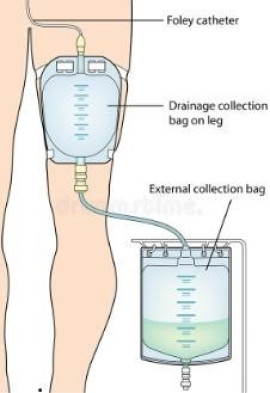
| ➢ A night bag is much larger and should hold all the urine that is drained from your bladder overnight.➢ It is connected to the bottom of your day bag and is called a closed system.➢ You will need to open the day bag outlet tap so urine can drain into the larger night bag.➢ Loosen leg straps when you get into bed.➢ Place the night bag into a container, i.e. an ice-cream container so if the bag leaks or the tap is left open, you won’t have a wet floor/carpet.➢ Your nurse will show you how to attach the leg bag to the night bag prior to leaving hospital. |
Supply and Maintenance of Day and Night Bags
Day Bags
These are usually changed once a week and will be supplied prior to your discharge.
Night Bags
- These are detached during the day and emptied into the toilet or a suitable container.
- To clean: flush the night bag with a strong stream of warm water for about a minute with stopper end open (push stopper across). Close the stopper end and add a “dollop” of dishwashing detergent into the top of the bag. Half fill the bag with warm water and shake the bag thoroughly to dislodge any debris. Open stopper and empty bag. Flush again with stopper end open until all detergent and debris has gone. Hang over towel rail to dry.
- If you need extra supplies of leg and night bags you will need to contact your district nurse.
Remember always wash your hands before and after touching your catheter or drainage bags.
Flip-Flo Valves

The flip-flo valve is a tap-like device which fits into the end of the catheter (suitable for both urethral and suprapubic). It offers you an alternative to using urinary drainage bags. Your bladder continues to store urine and can be emptied intermittently by releasing the valve.
- If you are likely to have your catheter removed in the future, then a flip-flo valve may make this more successful as your bladder function is more likely to be maintained. Please discuss this option with your doctor or nurse.
- You need to open and empty your flip-flo valve every 3-4 hours or more often if you feel the need to pass urine. Empty it prior to opening your bowels, as this will minimise leakage around your catheter.
- A flip-flo valve should be changed weekly.
- You may wish to tuck your flip-flo into your underwear or use a leg strap to secure it to your thigh. You do not need to keep the flip-flo lower than your bladder when it is not being emptied.
Sexual Intercourse
- Women can tape the catheter forward onto her abdomen/groin out of the way.
- The male needs to wear a condom.
- Men fold the catheter tubing down over the erect penis and apply a condom and tape it in place.
- Use plenty of water-soluble lubricant, i.e. KY Jelly – NOT Vaseline.
- If your catheter is causing you problems during sexual intercourse, do not hesitate to discuss this with your nurse or doctor.
Problem Solving
Urinary infection
Cause
- Bacterial contamination.
Signs
- Smelly, cloudy urine.
- Abdominal/back pain.
- Bleeding.
- Fever/shivering.
Treatment
- Increase fluid intake, it is recommended you drink two litres of fluid in a 24-hour period.
- Contact GP who may take a urine sample and prescribe a course of antibiotics.
No urine in the bag for a few hours
Cause
- The tubing could be kinked or bent.
- The bag may be above the bladder.
- You may not have been drinking enough fluid.
- Constipation.
- Blocked catheter due to debris.
Signs
- Very little or no urine passed into the bag.
- Abdominal discomfort or urge to urinate.
Treatment
- Check the placement of your catheter tubing and drainage bag.
- Try moving and walking around, this may dislodge a blockage.
- If no urine has drained, then contact your district nurse or GP who will attempt to clear the blockage.
- If none of the above are successful, the catheter will be removed and replaced.
Bleeding (a small amount of blood may occur at times)
Cause
- Irritation of the bladder, prostate or urethra by the catheter.
Signs
- Blood in the urine or around the catheter.
Treatment
- Increase your fluid intake.
- If bleeding persists, contact your GP or the district nurse.
- A urine sample may need to be taken for testing.
Bladder spasm / leakage from the catheter
Cause
- The bladder attempts to expel the catheter by creating pressure.
- This can force urine out around the catheter causing pain and leakage.
Signs
- Lower abdominal pain.
- Leakage of urine (bypassing).
Treatment
- If pain persists, contact your GP who may wish to trial a medication called Oxybutynin or Solifenacin which should help.
Catheter falling out
Cause
- Faulty balloon or damaged catheter.
- Bladder spasm.
- Pulling on catheter.
Signs
- Catheter is no longer in the correct place.
Treatment
- Seek immediate help from your district nurse, GP or the Emergency Department.
Urinary infection
Cause
- Bacterial contamination.
Signs
- Smelly, cloudy urine.
- Abdominal/back pain.
- Bleeding.
- Fever/shivering.
Treatment
- Increase fluid intake, it is recommended you drink two litres of fluid in a 24-hour period.
- Contact GP who may take a urine sample and prescribe a course of antibiotics.
No urine in the bag for a few hours
Cause
- The tubing could be kinked or bent.
- The bag may be above the bladder.
- You may not have been drinking enough fluid.
- Constipation.
- Blocked catheter due to debris.
Signs
- Very little or no urine passed into the bag.
- Abdominal discomfort or urge to urinate.
Treatment
- Check the placement of your catheter tubing and drainage bag.
- Try moving and walking around, this may dislodge a blockage.
- If no urine has drained, then contact your district nurse or GP who will attempt to clear the blockage.
- If none of the above are successful, the catheter will be removed and replaced.
Bleeding (a small amount of blood may occur at times)
Cause
- Irritation of the bladder, prostate or urethra by the catheter.
Signs
- Blood in the urine or around the catheter.
Treatment
- Increase your fluid intake.
- If bleeding persists, contact your GP or the district nurse.
- A urine sample may need to be taken for testing.
Bladder spasm / leakage from the catheter
Cause
- The bladder attempts to expel the catheter by creating pressure.
- This can force urine out around the catheter causing pain and leakage.
Signs
- Lower abdominal pain.
- Leakage of urine (bypassing).
Treatment
- If pain persists, contact your GP who may wish to trial a medication called Oxybutynin or Solifenacin which should help.
Catheter falling out
Cause
- Faulty balloon or damaged catheter.
- Bladder spasm.
- Pulling on catheter.
Signs
- Catheter is no longer in the correct place.
Treatment
- Seek immediate help from your district nurse, GP or the Emergency Department.


